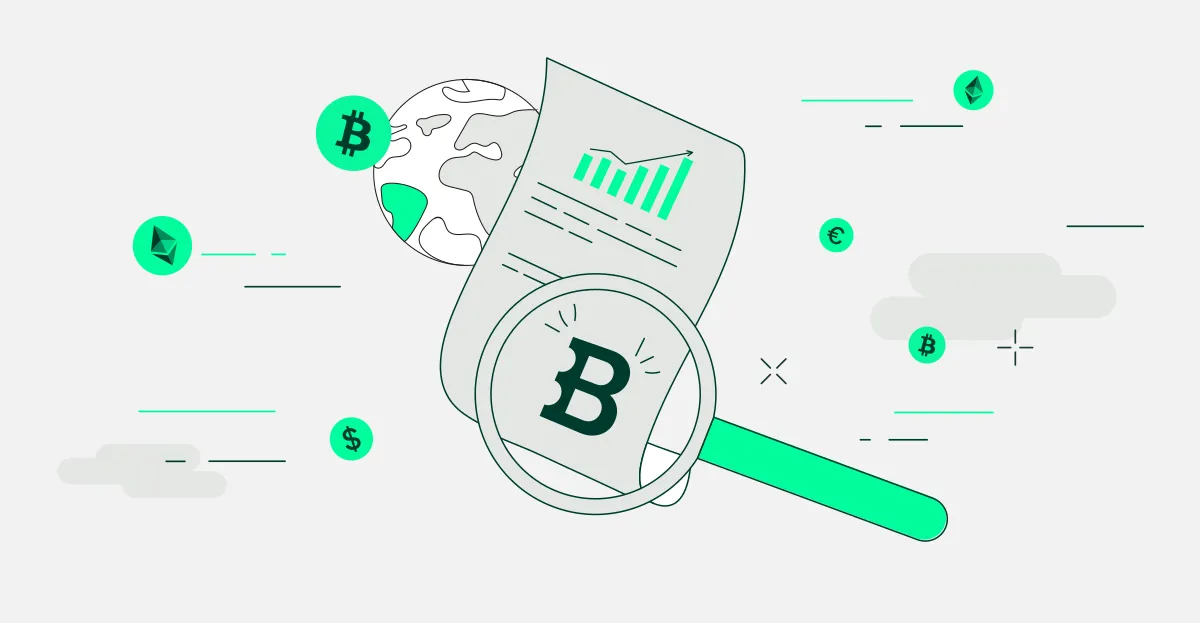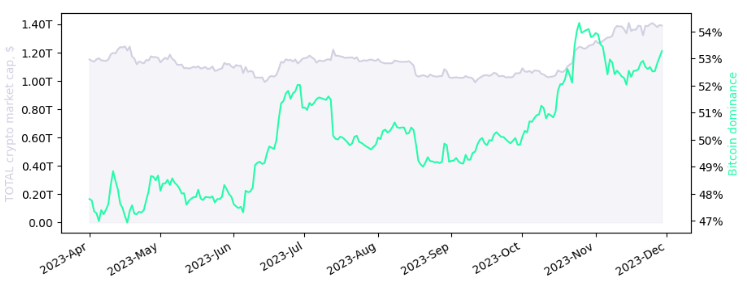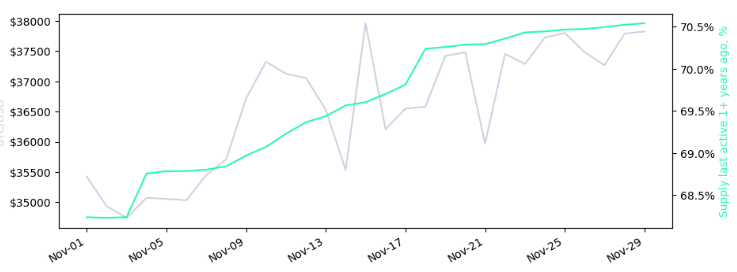Bitstamp Monthly Briefing – November 2023

Diving into November's crypto landscape! Every month, we handpick and highlight significant crypto events and trends, offering you an insightful glimpse into the future of this fast-evolving space. In this month's overview, we're delving into the intriguing developments in Bitcoin's supply mechanics and the revolutionary impact of blockchain exchanges on financial services. Our mission is to keep you informed and ready for the evolving landscape of cryptocurrency and blockchain technology.
Ready to explore? Let’s get started!
Monthly Recap: November 2023
The total crypto market cap rose by 10.6% month-over-month, reaching $1.39 trillion at November's end. Trading volume on the leading crypto spot exchanges we monitor also saw a 37% increase during this period, climbing to $286 billion.
BTC's market dominance dropped slightly by 0.8 percentage points month-over-month to 53.0%.
Total crypto market cap (grey) and BTC dominance (green)

Source: Total crypto market cap,Bitcoin dominance
*Calculated from $208bn, a corrected value from what we reported in our previous newsletter
Best performing CMC 100 assets in November
- + 355.1% TerraClassicUSD (USTC) - Terra Classic Labs made a strategic purchase of $25.6 million USTC, which sparked hope for ecosystems recovery
- + 235.7% FTX Token (FTT) - Price surged following SEC commentary hinting at a potential exchange reboot
- + 181.0% Celestia (TIA) - Listing on Binance and bullish sentiment in the community drove the price up sharply
Worst performing CMC 100 assets in November
- - 14.2% Conflux (CFX) – The price failed to break the $0.18 resistance level
- - 9.6% Bitcoin Cash (BCH) – EDX exchange delisting resonated negatively in the markets
- - 9.3% XDC Network (XDC) – The price hit multiple tops around $0.057 but failed to break the resistance
Key macro & crypto events in December 2023
- December 5: Crypto and Digital Assets Summit: Winter edition
- December 7: EU’s GDP and main aggregates report
- December 8: US employment report
- December 11-12: Digital Acceleration & Transformation Expo
- December 11-16: Taipei Blockchain Week
- December 12: US CPI Report
- December 13: FOMC Economic projections & FED press conference
- December 19: Inflation (HICP) report
Bitcoin's inactive holdings hit new highs
Investors are holding onto their Bitcoin for extended periods, potentially signaling an emerging bullish sentiment in crypto. The proportion of inactive Bitcoin (BTC tokens not traded in the past year) reached a new high of 70.54% in November, exceeding the previous peak of 69.35% set in July.

Source: Glassnode
One explanation for the recent HODLing is that longer-term conviction could be re-emerging among BTC traders, as they look beyond short-term rallies and expecting greater price increases in the future.
The anticipated fourth Bitcoin halving, scheduled for around April 23, 2024, may partly drive this shift in sentiment. The halving will reduce the rate at which new BTC are released into circulation by half. Many investors keenly look to halvings, because of their historical connection to market upswings, as do Bitcoin miners, who are reluctant to sell their BTC before the halving event, after which their mining rewards are slashed.
The growing institutionalization of crypto could also be indirectly influencing the recent increase in inactive Bitcoin. Inactive asset supply will increase with the growth of alternative investment instruments such as spot-based exchange-traded funds (ETFs) and cash-settled futures. For instance, with ETFs, issuers accumulate cryptocurrency and move it into custody, where it remains inactive. Nevertheless, investors can still engage in trading on an exchange through ETFs themselves.
Interestingly, this Bitcoin halving is expected to coincide with the time when global economies are adjusting their monetary policies to control inflation and support economic stability. As Bitcoin enters its quantitative tightening phase, governments worldwide will be considering increasing their money supplies. If fiat currencies expand their supply while Bitcoin restricts its own, BTC investors may observe a unique divergence, which could potentially propel Bitcoin's price upward.
Blockchain exchanges
Blockchain technology is transforming how financial services function. As blockchain enthusiasts explore the future possibilities of decentralization, examining past innovations and pivotal events that shaped the industry blockchain aims to revolutionize is intriguing.
Until the 1960s, securities settlement relied solely on physical processes. When a stock or bond traded, a paper certificate had to be physically moved from seller to buyer by a courier through lower Manhattan. An increase in trading activity after 1965 flooded Wall Street with more trades than its brokerage houses could manually process, leading to the “paperwork crisis” of 1967. The crisis forced exchanges to close on Wednesdays, shorten trading hours on other days, and extend settlement to T+5 — all to allow brokerages to work through their backlog of unsettled trades.
The back-office crisis led to considerable disorder, with reports indicating that approximately $400 million in securities went missing, stolen, or potentially lost, in the chaos. The crisis only began to ease during the bear market of 1969 when trading activity decreased to a more manageable level. However, the damage was done, and in subsequent years many investors moved to take control and self-custody their security certificates.
The lasting impact of the paperwork crisis is reflected in the current state of Wall Street. Computerization, the advent of NASDAQ, centralized clearing, and the emergence of large brokerages, all directly stem from the back-office turmoil of 1968.
This brief history of traditional finance (TradFi) development paves the way for understanding the emergence of blockchain technology. A recent paper, Electronification, trading, and crypto, demonstrates how blockchain technology can extend and improve the mission to make markets more efficient and transparent. For example, permissionless blockchains now enable new structures not previously possible with the traditional trading stack: the entire trading stack merges into a single, cohesive system, agnostic to participants.
This infrastructure comprises various components: the network, consisting of nodes facilitating communication through blockchain protocols; custody and settlement, involving tokens representing digital assets transferable among users and held in custody by both users and smart contracts; coordination and process, where the blockchain protocol serves as the foundational layer for communication and coordination, complemented by the smart contract protocol executing the business logic of the exchange mechanism; and price discovery, achieved through a straightforward formula, leveraging smart contract logic and token pools within them. Thanks to the publicly accessible trading infrastructure, which requires no single entity's ownership or control, anyone can create a market for any asset.
Looking to the past, the market structure shifts enabled by blockchains have the potential to continue to revolutionize financial services and better serve market participants. Yet, the widespread impact and long-term success of blockchains hinge significantly on mainstream adoption and the regulatory climate surrounding these innovative technologies.
Recommended reads
Interview with Domo, the Ordinals creator by Boffin
The article dives into the creation and impact of the BRC-20 token standard by its creator, Domo. It highlights the astonishing influence BRC-20 has had on the Bitcoin network, revealing key statistics and features, while presenting an insightful interview with Domo about the standard's origins and future implications within the crypto landscape.
The complete story of Open AI by Mike Solana
If you’ve been puzzled by the abrupt firing (and re-hiring) of OpenAI’s CEO Sam Altman in November, you’re not alone. Mike Solana provides a comprehensive play-by-play of recent events at the AI juggernaut.
King Henry VIII’s Inflation Scheme by Daniel Prince
Explore King Henry VIII's historical currency manipulation in 1542, where he secretly reduced the precious metal content in England's coinage, leading to economic chaos and public distrust. The article draws parallels between this ancient scheme and modern-day monetary policies of central banks, advocating for Bitcoin as a decentralized alternative that preserves value, challenging the centralized control of traditional currencies.
Why it's great to be an investor now by Justin Carbonneau
Investors in 2023 are benefiting from reduced costs in trading fees, technological advancements enabling fractional share purchases and T+1 settlement, and a wealth of tools offering professional-grade analytics. The emergence of new asset classes like cryptocurrencies and the proliferation of investment-related content through blogs, podcasts, and social platforms have further empowered investors with more choices and resources to enhance their investment decision-making and education.
No information in this blog is intended to provide any personal investment services or advice nor is it an investment recommendation. Clients are responsible for making their own investment decisions. Bitstamp accepts no responsibility for any damage and/or loss arising from the use of information provided herein. Past performance is not necessarily an indicator of future results. Please consider your individual position and financial goals before making an independent investment decision.
Bitstamp is licensed to engage in virtual currency business activity by the New York State Department of Financial Services. Licensed as a Money Transmitter by the New York State Department of Financial Services
Not offered in the following states: Hawaii and Nevada
Bitstamp UK Limited is registered with the Financial Conduct Authority under the Money Laundering, Terrorist Financing and Transfer of Funds (Information on the Payer) Regulations 2017.
"This webpage has been approved as a financial promotion by Bitstamp UK Limited which is registered with the UK’s Financial Conduct Authority. Please read the Risk Warning Statement before investing. Cryptoassets and cryptoasset services are not regulated by the Financial Conduct Authority. You are unlikely to be protected if something goes wrong. Your investment may go down as well as up. You may be liable to pay Capital Gains Tax on any profits you earn."